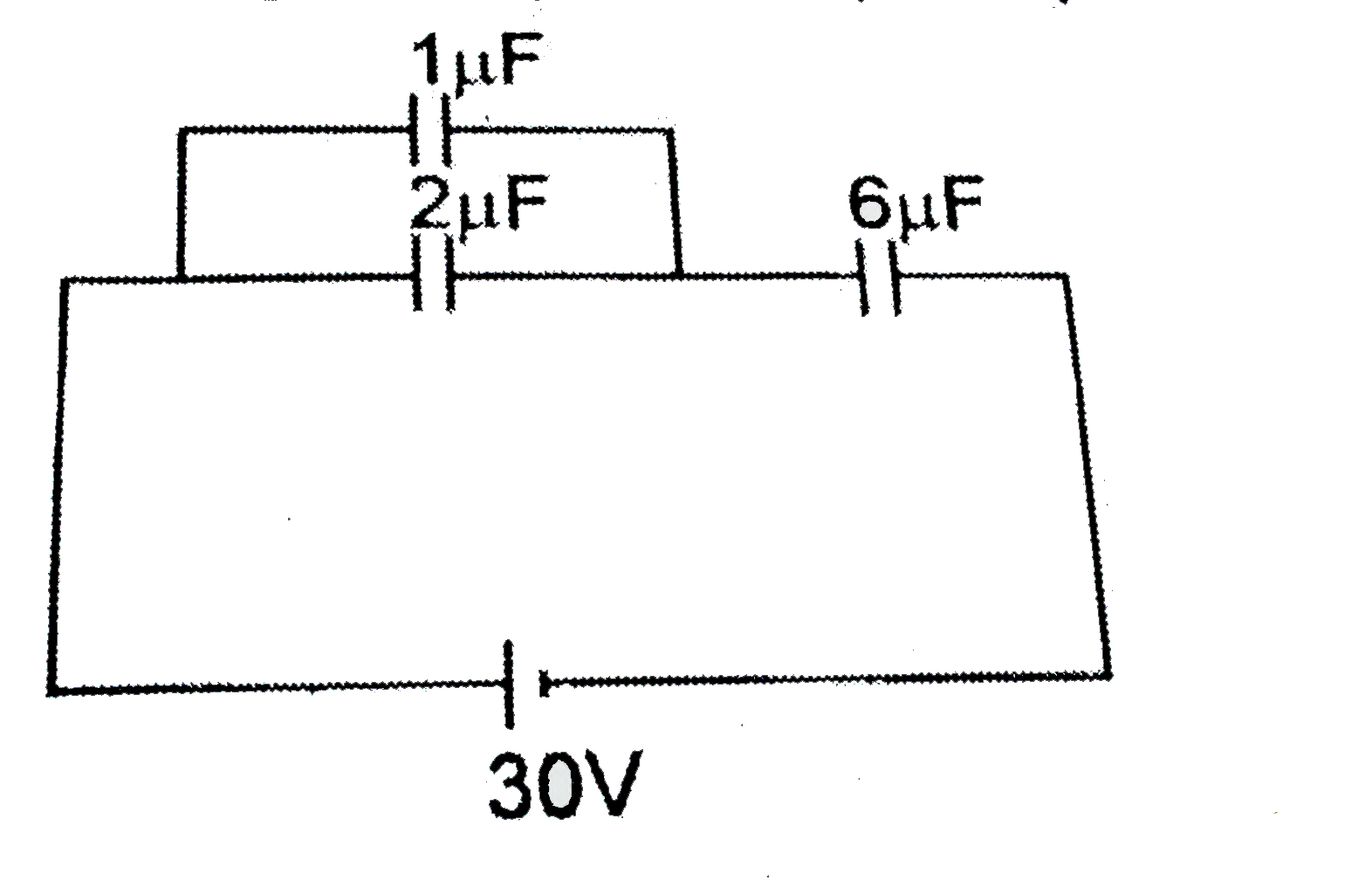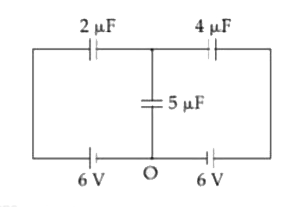A battery of emf 20V is connect to two capacitors 1μF and 3μF in series. 1μF capacitor withstands a maximum of 9V and 3μF withstands a maximum voltage of 6V then
1μF capacitors break
2μF capacitors break
both will break
no capacitor will break
The correct Answer is:A
To solve the problem step by step, we will analyze the given information and calculate the voltages across the capacitors connected in series.
Step 1: Understand the Configuration
We have two capacitors connected in series:
- Capacitor 1 (C1) = 1 µF
- Capacitor 2 (C2) = 3 µF
- Battery emf (V) = 20 V
Step 2: Calculate the Equivalent Capacitance
For capacitors in series, the equivalent capacitance (C_eq) can be calculated using the formula:
1Ceq=1C1+1C2
Substituting the values:
1Ceq=11μF+13μF=3+13μF=43μF
Thus,
Ceq=34μF
Step 3: Calculate the Charge on the Capacitors
The charge (Q) stored in the equivalent capacitor when connected to the battery can be calculated using:
Q=Ceq×V
Substituting the values:
Q=(34×10−6F)×20V=15×10−6C=15μC
Step 4: Calculate the Voltage Across Each Capacitor
1. Voltage across Capacitor 1 (V1):
V1=QC1=15μC1μF=15V
2. Voltage across Capacitor 2 (V2):
V2=QC2=15μC3μF=5V
Step 5: Check the Maximum Voltage Ratings
- Capacitor 1 can withstand a maximum of 9 V, but it has 15 V across it. Therefore, it will break down.
- Capacitor 2 can withstand a maximum of 6 V, but it has only 5 V across it. Therefore, it will not break down.
Conclusion
The 1 µF capacitor will break down because it exceeds its maximum voltage rating, while the 3 µF capacitor will function properly.
Final Answer
The 1 µF capacitor will break down.
---
We have two capacitors connected in series:
- Capacitor 1 (C1) = 1 µF
- Capacitor 2 (C2) = 3 µF
- Battery emf (V) = 20 V
For capacitors in series, the equivalent capacitance (C_eq) can be calculated using the formula:
1Ceq=1C1+1C2
Substituting the values:
1Ceq=11μF+13μF=3+13μF=43μF
Thus,
Ceq=34μF
The charge (Q) stored in the equivalent capacitor when connected to the battery can be calculated using:
Q=Ceq×V
Substituting the values:
Q=(34×10−6F)×20V=15×10−6C=15μC
1. Voltage across Capacitor 1 (V1):
V1=QC1=15μC1μF=15V
V2=QC2=15μC3μF=5V
- Capacitor 1 can withstand a maximum of 9 V, but it has 15 V across it. Therefore, it will break down.
- Capacitor 2 can withstand a maximum of 6 V, but it has only 5 V across it. Therefore, it will not break down.
The 1 µF capacitor will break down because it exceeds its maximum voltage rating, while the 3 µF capacitor will function properly.
The 1 µF capacitor will break down.
Topper's Solved these Questions
- APPENDICES ( REVISION EXERCISE )Book:AAKASH SERIESChapter:APPENDICES ( REVISION EXERCISE )Exercise:REVISION EXERCISE (CUTTENT ELECTRICITY )
Explore 108 Videos
- APPENDICES ( REVISION EXERCISE )Book:AAKASH SERIESChapter:APPENDICES ( REVISION EXERCISE )Exercise:REVISION EXERCISE (MOVING CHANGES & MEGNETISM)
Explore 95 Videos
- APPENDICES ( REVISION EXERCISE )Book:AAKASH SERIESChapter:APPENDICES ( REVISION EXERCISE )Exercise:REVISION EXERCISE (MAGNETISM AND MATTER )
Explore 52 Videos
- ALTERNATING CURRENTBook:AAKASH SERIESChapter:ALTERNATING CURRENTExercise:EXERCISE - III
Explore 24 Videos
- APPENDICES (REVISION EXERCISE)Book:AAKASH SERIESChapter:APPENDICES (REVISION EXERCISE)Exercise:LAW OF MOTION
Explore 128 Videos
Similar Questions
The charge in the 2μF capacitor at steady state is

View SolutionThree capacitors 2μF, 3μF and 5μF can withstand voltages to 3V,2V and 1V respectively. Their series combination can withstand a maximum voltage equal to
View SolutionA Capacitor of capacitance C1=1μF can withstand a maximum voltage V1=6.0 KV while another capacitor of capacitance C2=2.0μF withstands the maximum voltage V2=4.0 KV . What maximum will the system of these two capacitance withstand when connected in series as shown below .

View SolutionA capacitor of capacitance C1=1μF withstand a maximum voltage of V1=6KV, and another capacitor of capacitance C2=2μF, can with stand a maximum voltage of V2=4KV. If they are connected in series, what maximum voltage will the system withstand?
View SolutionIn the given circuit find out charge on 6μF and 1μF capacitor.

View SolutionIn the circuit shown , charge on the 5μF capacitor is :

View SolutionIn given circuit, ratio of charge on 2 μF capacitor to the charge of 3 μ F capacitor will be

View SolutionThe charge on 4μFcapacitor in the given circuit is (inμC)

View SolutionA capacitor of capacitance 6 μF is connected with an emf sourface 3 V. Electrostaci energy stored in the capacitor is
View SolutionWhile working on a physics project at school physics, lab, you require a 4 μF capacitor in a circuit across a potential difference of 1 k V. Unfortunately, 4 μF capacitors are out or stock in your lab but 2 μF capacitors which can withstand a potential difference of 400 V are available in plenty . if you decide to use the 2 μF capacitors in place of 4μ F capacitor minimum number of capacitors required are
View Solution